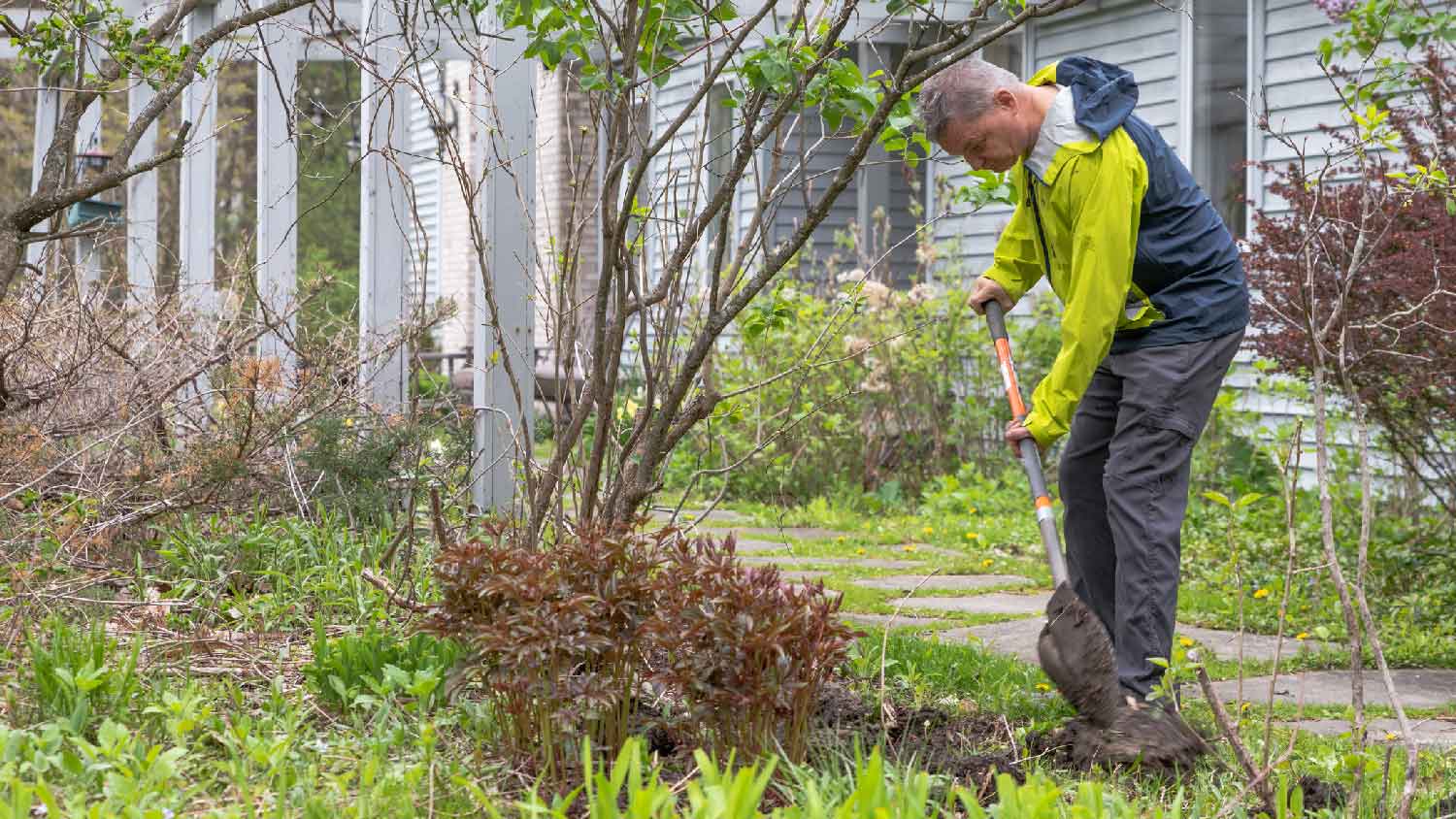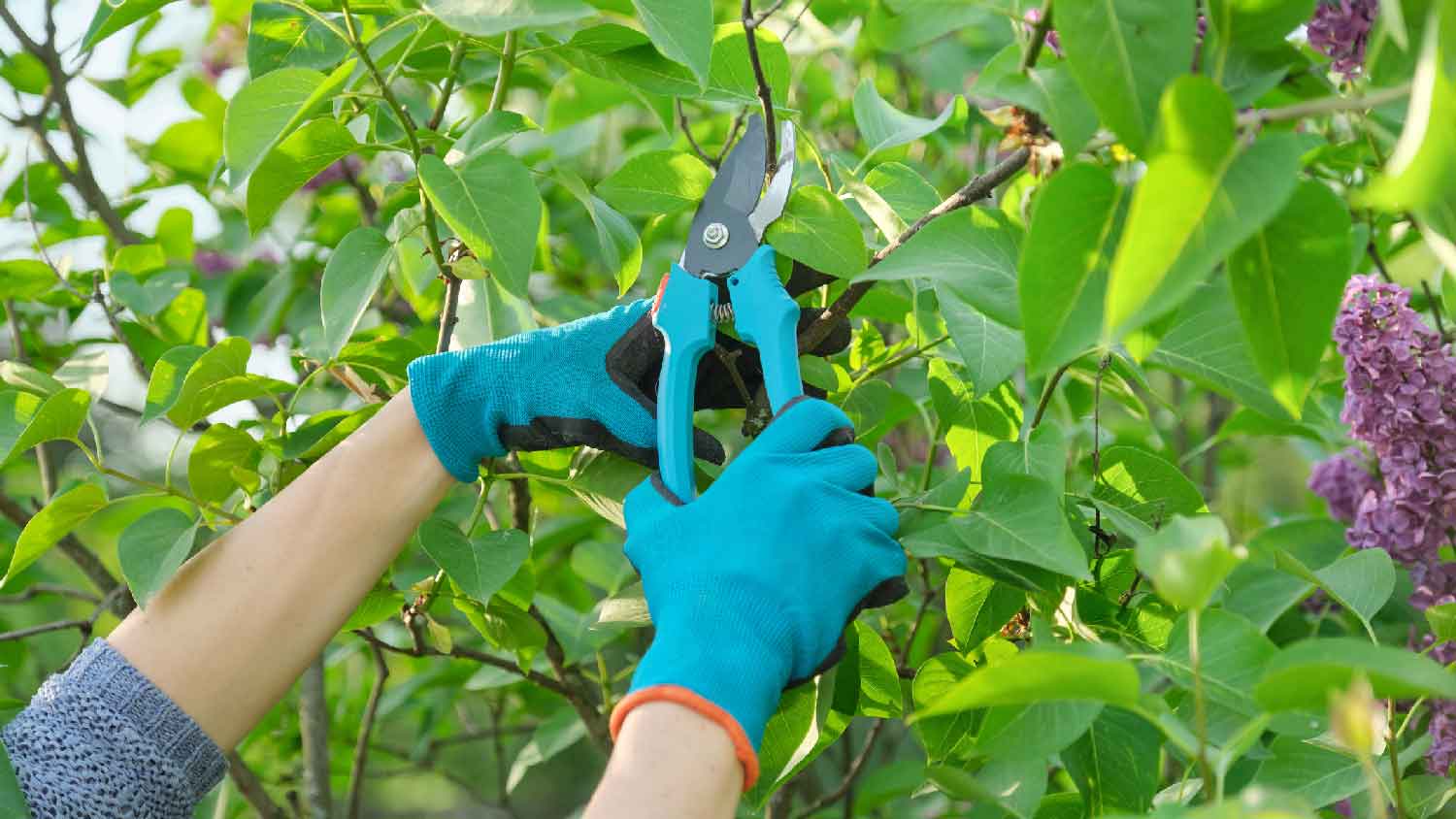
Ivy might look pretty, but you probably don’t want it in your garden. Learn how much it’ll cost to remove ivy by type, treatment method, and more.
Keep your garden healthy and blooming by removing an old, diseased lilac bush


Large, established lilac bushes may require a tow strap and access to the power of a truck or tractor to remove.
Lilacs can easily grow back if all of the roots aren’t removed.
A landscaping pro will remove a lilac bush quickly and completely without damaging the surrounding area.
Lilac bushes provide beautiful, fragrant flowers during the spring and summer months. Yet, these invasive bushes can quickly become overgrown and take over your entire yard if not adequately tended to. Use our guide to learn how to remove a lilac bush safely and efficiently.
Lilac bushes, while nice to look at, are an invasive species. If you don’t maintain them with regular prunings, they can easily take hold of your entire garden. Lilac bushes send suckers up through their roots—which quickly reproduce and can overtake your yard.
Mainly, you must remove a lilac bush to keep it from spreading. However, lilac bushes can also become diseased, which can quickly infect the rest of your garden if not taken care of immediately.
You can expect to pay between $450 and $1,375 for professional shrub removal. Your total cost will depend on several factors, including the size of the lilac bush, the amount of shrubbery, how far down the roots go, accessibility, and the location of the lilac bush. Be sure to hire a shrub removal specialist who has prior experience removing lilac bushes to ensure best results.
Because lilac bushes are invasive, grow quickly, and have deep roots that can rapidly reproduce, you’ll need to obtain specific tools and supplies before starting this project. Here’s what you’ll need:
Gloves
Shovel
Spade
Pruning shears
Chainsaw
Tree trimmer
Chain
Tow strap
Plywood (optional)
Concrete blocks (optional)

There are several ways to safely remove a lilac bush, including pulling the bush out by hand, using a shovel or spade, using a truck or tractor to pull it out, or you can kill the lilac bush using chemicals. The most important thing to note is that you must pull all the roots out of the ground or else the lilac bush will quickly regenerate.
You can pull it out by hand if the lilac bush is relatively young and without deep roots.
Thoroughly water the plant and the surrounding ground to loosen the soil.
Slowly pull out the bush by hand, ensuring you get to the root ball.
Fill in the hole with fresh soil or plant a new bush.
Moisten the lilac bush and the surrounding ground.
Grab a shovel or a spade and begin digging down on every side of the bush.
Remove plenty of soil around the roots to help loosen the root ball.
When you see the roots, take a pair of pruning shears and cut them away.
When you get to the bottom of the roots, pull them out by wedging your shovel underneath the root ball. Make sure to remove the entire root ball as you pull.
Fill in the hole with fresh soil or a new plant.
For older, larger lilac bushes, a shovel and spade may not have enough force to remove the bush from the ground—and you’ll need something with more heft.
Tie a tow strap or a chain around the base of the lilac bush and attach it to a truck or tractor.
Drive the truck or tractor slowly, adding some tension to the bush.
As the truck continues to pull out the bush, start cutting the roots with pruning shears.
Dig out more soil around the roots to loosen the root ball.
Continue to add more tension and slowly pull the bush out of the ground until the root ball emerges.
Extract the entire bush, including the root ball.
If the bush still won’t budge, place plywood and concrete blocks on either side of the bush.
Use the force of the plywood and concrete to push against the lilac bush—essentially pulling it up as the truck moves forward.
Fill in the hole with fresh soil or a new bush.
Read the instructions carefully and take the necessary safety precautions before using the herbicide.
Cut the lilac bush down to ground level with a chainsaw, pruning shears, or a tree trimmer.
Put on protective gloves and wear a long-sleeved shirt and pants.
Apply an herbicide to the lilac bush and its roots. Ensure the chemical agent includes Glyphosate, which blocks an enzyme essential for plant growth.
Monitor the lilac bush until it is dead, typically taking a few days.
Properly dispose of the dead plant according to your local municipality’s guidelines.
Keep children and pets away from the area until you’re ready to fill in the soil or plant a new bush.

To prevent lilac bush overgrowth, you’ll want to take the following steps to keep your bush in good, healthy condition:
Hire a professional to prune for your lilac bush.
Put new, fresh mulch in your garden annually.
Provide regular feedings and nutrients.
Monitor your lilac bush for signs of disease or damage.
If you need to remove a lilac bush, the best time is in late winter or early spring.
If you’re an experienced gardener and have the proper tools and supplies, you can remove a lilac bush yourself. You’ll save between $450 and $1,375 in costs. But you’ll need to ensure that you remove all of the roots, or else the lilac bush will grow back and overtake the rest of the plants in your garden.
We recommend hiring a landscaper near you to complete the task efficiently and safely. You can expect to pay $50 to $100 per hour in labor. Landscaping pros have the tools, supplies, knowledge, and experience to ensure the job is done right the first time.
From average costs to expert advice, get all the answers you need to get your job done.

Ivy might look pretty, but you probably don’t want it in your garden. Learn how much it’ll cost to remove ivy by type, treatment method, and more.
.jpg?impolicy=leadImage)
Landscaping your yard adds curb appeal and expands your home’s living space into the outdoors. Learn how much landscaping costs for various projects.

Leveling your yard can help with drainage and prevent damage to your home. Learn the cost to level a yard in Columbus, OH, and what factors can affect the price.

There are reasons to grade or slope your yard beyond aesthetics—drainage is the main one. Read on and learn how to have an informed discussion with your pro.

St. Augustine grass generally fares well in warm climates, but brown spots happen. Here are some ways to revive seemingly dead St. Augustine grass.

The cost of topsoil varies based on the size of the area and the depth, as well as prep and labor. This article covers everything to factor into your budget.